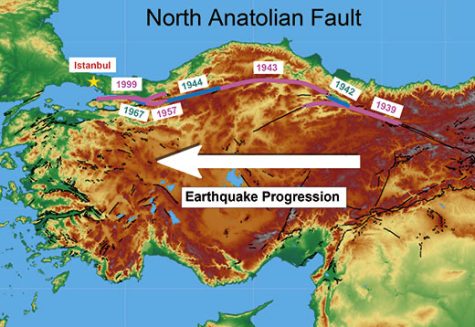Earthquake Thread in Istanbul
As one of the oldest cities in the world, Istanbul has been the centerpiece to many civilizations. If I start to recite its story, I would need days, even weeks….so I will summarize briefly. Istanbul is as sacred as Jerusalem, as modern as Paris, as splendid as Rome, and as beautiful as London. Moreover, it is older and grander than any of these cities. Nowadays, Istanbul has the largest population in Europe. It’s one of the most touristic cities in the world and has magnificent architecture and rich history.
Recently, there was a huge snowstorm in Istanbul. In some parts of the city, snow measured over a meter which is unusual. In Istanbul, some winters it snows, but in the last 20 years, it has never snowed that much. After the population density increased enormously in recent years, the city became overpopulated. Thus, people who are inexperienced against this type of natural disaster led the city to chaos. All roads were closed, life stopped in the city. The city municipality worked day and night to clear out the roads and salt them, but there are hundreds of different roads everywhere in the city which made it difficult to clear all of them. The city of Istanbul failed to manage the situation.
The city’s failure to manage this snowstorm is relevant because Istanbul will face a giant earthquake in 3 years. However, Istanbul is not ready for that, not even close. It is expected to be in 2022, but seismologists can never be 100% sure. The North Anatolian Fault Line, where the earthquake is expected to happen, is roughly 1300 km long from Lake Van to the Marmara Sea, and already has a history of cracks. The first big crack was in 1939, in Erzincan, magnitude 7.9. It was a year after Turkey became independent, and this earthquake was a big disaster. Over the following 3 years, there were 3 big earthquakes: Tokat (Niksar-Erbaa) 7, Samsun (Tosya-Ladik) magnitude 7.5, Bolu (Gerede) magnitude 7.5. There have been many small and medium-sized earthquakes. Then it stopped for 13 years, and in Bolu (Abant) there was magnitude 7.1. 10 years after, in Bolu (Mudurnu), one more big earthquake followed. And the last, the biggest, earthquake happened on August 17, 1999, in Izmit. This earthquake affected Istanbul and caused 41,000 buildings to collapse.

As you can see from the map, the earthquakes follow the fault line from east to west. It’s inevitable that there will be a huge earthquake in Istanbul. It has been known for many years, but the question is “What is being done to reduce this earthquake’s effects?”
The answer is nothing. Apart from some urban transformations in some boroughs of Istanbul, nothing significant has been done. For 15 years, AKP (Justice and Development Party) municipality built shopping malls with meeting and escape areas where people could gather when the earthquake hits. Poorly constructed buildings and buildings made of sea sand will not withstand the coming earthquake.
At least 2.5 million people will be impacted by this earthquake in the current circumstances.
Remember; Buildings cause people to die, not earthquakes. Instead of taking precautions, the government chooses to trust God. As they always do.
NERC- Getting Ready for the Next Big One
Here are the Districts that will be most Affected by the Earthquake


